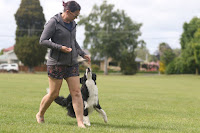My interest in canine fitness begun when we discovered that Brody was getting a sore neck from the way I had taught some tricks, and the repetitions at which I was asking him to do them. As I got smarter about how I taught tricks, I also got smarter about how teaching 'tricks' could help specific skills in my sport.
Here's a few examples:
- Cavaletti can not only increase the aerobic fitness required to be able to maintain trotting for a sustained period during heelwork, but will also help with gait length, striding rhythm, and the general proprioception needed to hold a strong heel position.
- Holding a stationary stay position for a long period actually requires a large amount of muscle strength. Adding strength and instability work in positions (sit, down, and stand) will improve the ease at which an obedience dog can physically hold a stay position.
- Crooked sit's can be a result of a failure to teach correct form, a structural or injury issue, or most commonly a lack of muscle strength. Whilst fitness cannot correct structure, it can help you rule out an injury, re-teach correct form, and build muscle strength.
- For most dogs, a heel position with a high head position is not anatomically normal, or comfortable. The large triangular muscle on the top of the back over the shoulder blades is involved in core stability and movement in the front limbs. This muscle is also shown to be one of the first to fatigue with exercise. That means that if your dog does not have a strong core, they physically will not be able to maintain this heel position.
- Movement through positions in distance control can be taught with foundation fitness skills, that means dogs will develop the correct form and muscle memory.
This is just a few examples of how fitness could benefit an obedience dog. Fitness exercises are a must for any performance dog, and can be adapted not only for the dog, but also for your sports!







No comments:
Post a Comment
Note: only a member of this blog may post a comment.